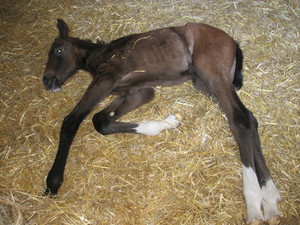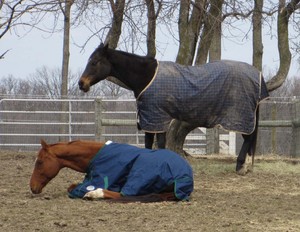That horse isn't dead - he's merely resting (and more facts about equine sleep)
The sun is out after a long, cold, cloudy winter. How nice to lie down on the warm, soft earth and feel the sun’s rays.
Spring has come, and with it come visits to the farm from concerned residents who drive by and report dead horses in the pasture. I am serious.
About the visits, not dead horses. The worried visitors are reassured that the horses are actually quite well, just napping.
Cyclists frequently pass our barn in pursuit of a nice trip to the rural peace outside Ann Arbor.
Alarmed at motionless equines lying about, one bicyclist sped up the drive to the barn and urgently broke in as a small group of friends chatted. “Come quick, there is a dead horse in the pasture!” he said.
He was the fourth person in about two weeks to report such a sighting, and we could not help but gently laugh and tell him we were quite sure the horse was OK. Now annoyed and worried, he pedaled back down the driveway, muttering about calling the Humane Society. A half hour later, he biked back home, past the farm the other way, only to find all the horses moving around and eating, full of vim and vigor.

A newborn foal resting in the "lateral recumbent position" — not quite asleep.
Kathy Lundberg | Contributor
Sleep is an important part of life. Good sleep facilitates mental and physical health in many ways. Humans like to get a solid block of time to lie down and rest, about seven to eight hours a day for adults. We cycle through Stages 1, 2, 3, 4, and REM (rapid eye movement) sleep every 90 to 110 minutes or so, several times throughout the night.
Befitting a prey animal that evolved on open plains whose life may depend on waking quickly and fleeing, horses sleep for shorter periods of time, more frequently. They can sleep standing or lying down, but they lie down only when they feel comfortable and safe from danger.
In the wild or in a pastured herd, you may observe a “sentinel effect” where several horses lie down and zone out while one keeps more alertly vigilant. Horses who are kept alone without a buddy or stalled with little equine contact are more likely to experience sleep disorders. Without a herd to depend on, the lone horse must always be on guard.

One horse rests in sternal recombency while his buddy stands guard. Note one hind leg of the standing horse is in passive stay position, the other leg resting.
Kathy Lundberg | Contributor
Most domestic horses spend much of their time in restful drowsiness. Their food is provided for them by us — they need not spend energy and time searching for it. Horses often rest standing with their weight on both front legs and one hind leg, the other back foot cocked.
To keep from tipping over as they drift off, they engage a “passive stay mechanism” in the hind leg carrying the weight. This locks the leg in place, requiring less energy to keep standing.
Occasionally the horse will shift weight from one hind leg to the other. The stay mechanism allows horses to stand on their feet longer than other domestic animals, ready to take off with a moment’s notice.
Horses may spend anywhere from four to 15 hours a day in standing rest, but only a small part of that time is actual sleep, taken in short naps lasting only a few minutes at a time. Total sleep time may range from a couple minutes to a few hours per day.
As with people, horses need REM sleep. To achieve REM, they must be lying down. Horses spend about two to four hours on average lying down in the course of a day, concentrated during nighttime hours.
Youngsters sleep more than adults. They lie down in either “sternal recumbency” (legs curled under) or “lateral recumbency” (side-sleeping).
REM sleep is thought to occur in horses only while side-sleeping. A horse’s requirement for REM sleep may be very low — perhaps minutes per day. In researching this article, I found limited scientific information on equine sleep research from which to draw.
Horses can suffer from sleep deprivation. If a horse does not get enough sleep, it may suddenly collapse to the ground rather than circle and carefully lower itself down, as usually occurs. This is referred to as “sleep crashing.”
Cuts and scrapes on the front of the front limb knee joints may be an indication of this. Sleep deprivation may occur for three main reasons, says Dr. David Paton in a recent article on sleep in horses.
The horse may experience physical pain while attempting to lie down, and avoid doing so. He may feel unsafe in his environment and psychologically avoid sleep. Finally, monotony-induced excessive boredom may occur in a place he is comfortable, such as standing in cross ties, having his hair braided to go to a show.
Sleep crashing is not the same as narcolepsy, which is thought to be a more rare neurological disorder .
Next time you bike or drive by a farm where a horse or two are lying down, flat on the ground, don’t worry. That horse, dead to the world for appearances from afar, is more likely to be feeling especially safe, restful and happy. Enjoy your ride in the countryside!
Kathy Lundberg is a regular contributor on AnnArbor.com's pet section where she addresses topics regarding horses. She is owner of Scio Church Stables. She welcomes your contact via email.


Comments
Sarah Rigg
Tue, Mar 22, 2011 : 1:28 p.m.
This was really fascinating - thanks for sharing it!
Trumpet
Tue, Mar 22, 2011 : 1:07 p.m.
We have had the same concerned passers by, especially when we have horses in lateral recumbancy. We have a herd of 6 and always have a sentinal keeping watch while the others are sleeping. I always enjoy seeing the horses "sun bathing" in the spring when the ground soaks up the warmth and they are all stretched out. Life is good !